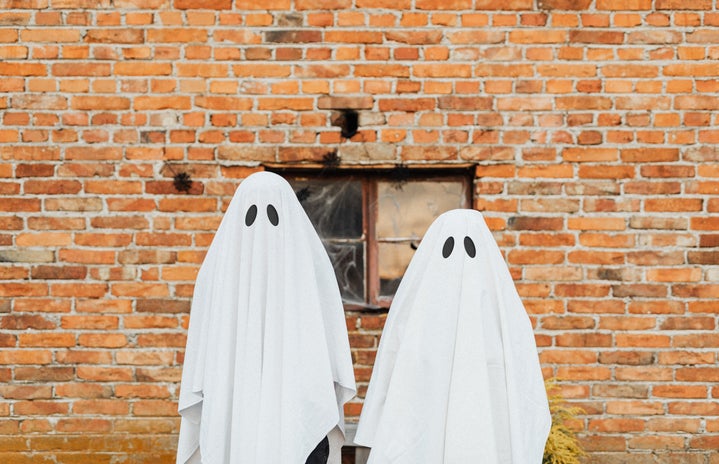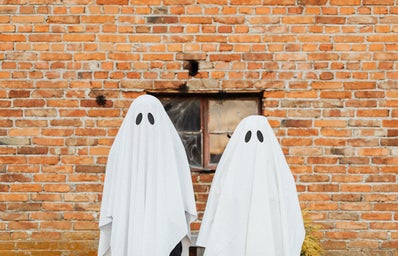Since I was old enough to make my own Halloween costumes, I did exactly that. I hated the scratchy, poor-quality, packaged costumes growing up—what I was able to piece together from everyday clothes was always more comfortable and unique. Little did I know that my costume choice was not only the cutest but one of the most sustainable ways to celebrate Halloween. Every year, approximately 35 million costumes find their way into U.S. landfills. So, in the spirit of the season, I want to share my experience and provide you with the ultimate guide to putting together a sustainable and super cute Halloween costume.
STEP 1: RESEARCH & PLANNING
The key to creating your perfect sustainable Halloween costume is to plan, plan, plan. Rome wasn’t built in a day—and neither is a stylish, eco-friendly costume. First, you must have an idea of who or what you want to dress up as. When selecting a character, ask yourself: does their ensemble translate easily to clothes already at your disposal? If not, could the missing elements be feasibly thrifted or borrowed? Will you need to buy an excessive amount of unnecessary, single-use items to complete this character’s look?
Once you’ve chosen your character, it’s time to brainstorm. At this stage, I recommend creating a Pinterest board with ideas for each component of your costume, from clothing to accessories to makeup. By searching “[character] homemade Halloween costume,” you’ll find inspiration for how to use everyday clothing to imitate your character.
STEP 2: PUTTING TOGETHER YOUR COSTUME
So, you’ve chosen a character and have a good idea of the pieces you’ll need to recreate their look. Now comes the exciting part: the costume-making process. There are several avenues you can explore to gather the necessary components for your costume. Each method offers its unique benefits, so don’t be afraid to mix and match to find the perfect fit for your needs.
Of course, the most sustainable thing you can do is utilize the clothing already in your closet; that said, the pieces we have don’t always fit the “spooky” Halloween vibe. In that case, I recommend first reaching out to friends and family who would let you rifle through their closets and borrow an item or two. If you’ve exhausted these tactics and are still missing parts of your costume, shopping at your local thrift stores is an environmentally friendly (and wallet-friendly) way to find gently-loved pieces you can customize to suit your needs. And, as a last resort, online resale websites such as Depop, ThreadUp, and eBay are best for finding the really unique pieces that you may have a hard time thrifting locally. Just be vigilant about avoiding the drop shippers rampant on these sites, and be mindful of purchasing pieces you don’t see yourself using once the season is over.
STEP 3: THE FINISHING TOUCHES
Now, for my favorite part of the costume-making process: the details. This is where the real fun and creativity come into play as you combine the individual pieces you’ve gathered to create a unique, uniform costume that’s all your own. It’s a chance to let your imagination run wild and bring your character to life in a sustainable way, and it’s also the step that will vary the most from costume to costume.
Have you thrifted or already own pieces in the style you need, but the color is all wrong? Consider dyeing them on your stovetop— all you need is hot water, dish soap, and fabric dye. Does your costume require little details such as buttons, bows, jewels, patches, or fabric strips? Use a needle and thread or a temporary adhesive to attach these items for easy removal later. Likewise, make use of old clothing items by cutting them up, dying them, and using them for accents instead of buying new fabric. If your costume requires a mask, consider using makeup, biodegradable glitter, and/or special effects to achieve your desired look. Similar to clothing, thrifted jewelry and shoes are less expensive and more environmentally friendly than anything for sale at major retailers. If you need more “unique” accessories, consider making them yourself from recyclable materials such as paper and cardboard, avoiding paint if possible, as that will hinder your ability to recycle these materials later.
When curating an eco-friendly Halloween costume, mindfulness and creativity are key. Each costume will have different needs, and the best you can do is seek out the most sustainable avenue available to you. Remember, there’s no such thing as perfection. Even if you purchase a plastic accessory or end up donating an item afterward, doing something is better than doing nothing at all. You have the power to make a difference in your own way.


